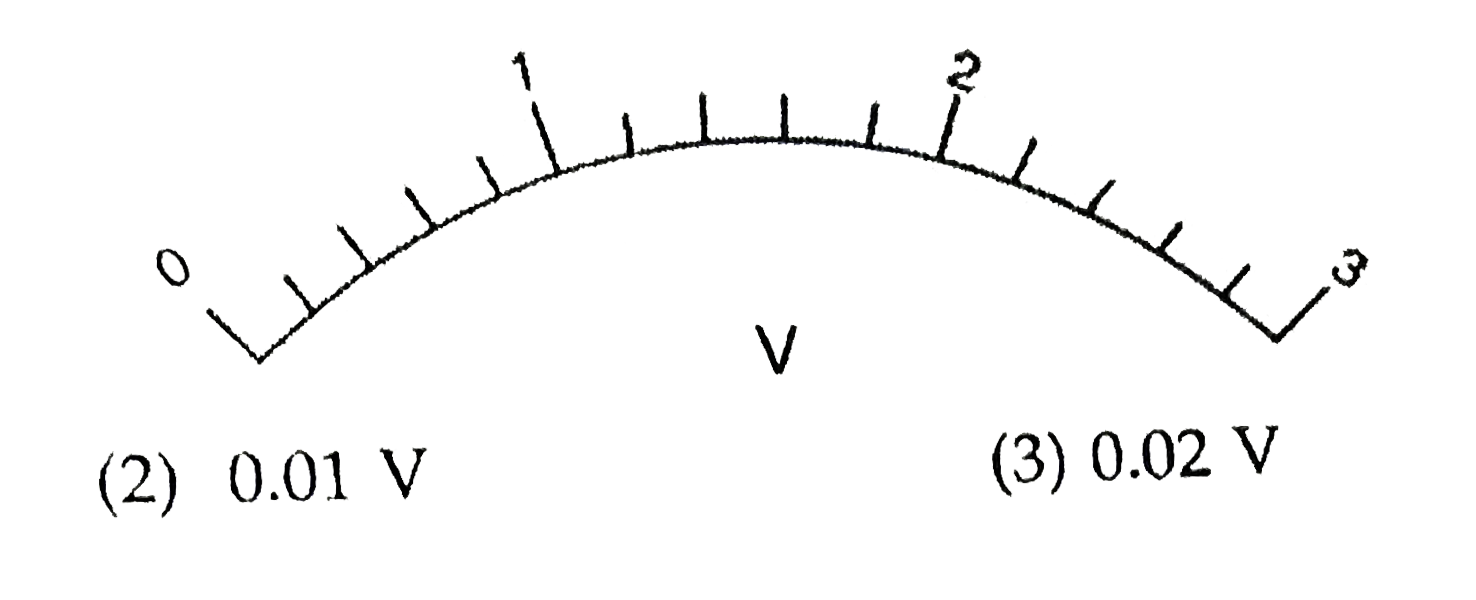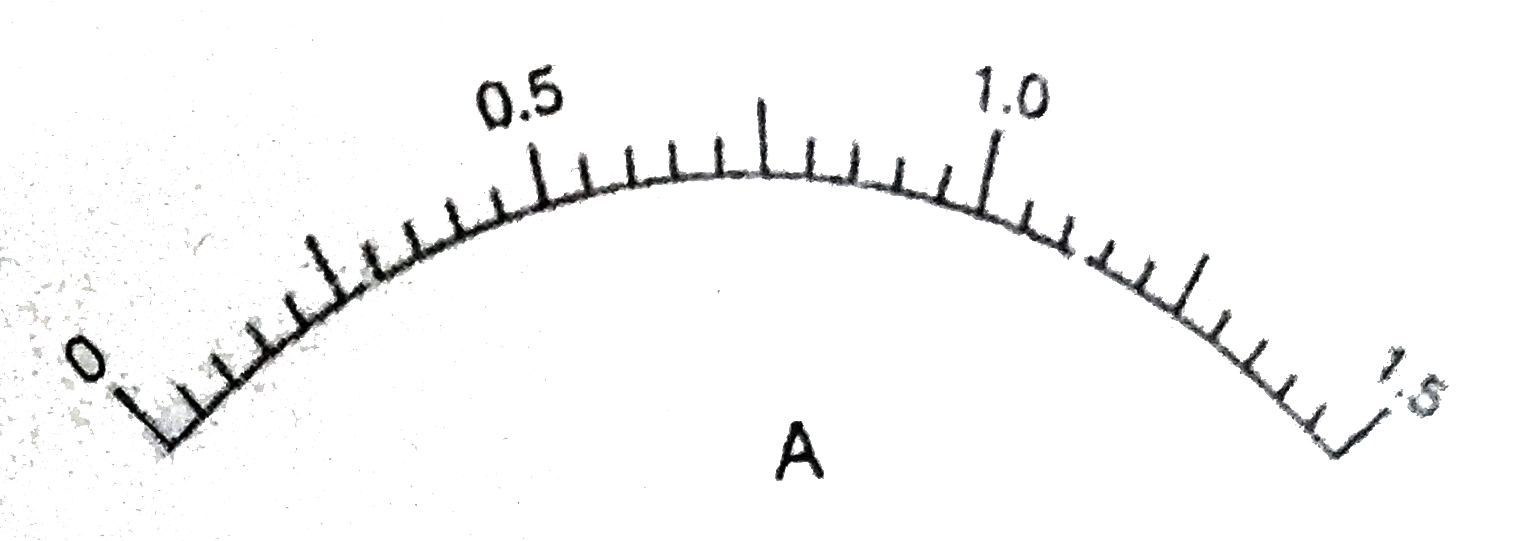The following pieces of apparatus are available in a laboratory :
Battery : adjustable from 0 to 6 V
Resistors : 3Ω and 6Ω
Ammeters : A1 of range 0 to 5 A , least count 0.25A
A2 of range 0 to 3 A , least count 0.1A
Voltmeters : V1 of range 0 to 10 V , least count 0.5V
v2 of range 0 to 5 V , least count 0.1 V
For the experiment to find the equivalent resistance of the parallel combination of the two given resistors, which is the best choice ?
Equivalent resistance =3×63+6Ω=2Ω
Maximum current to be measured =6V2Ω=3A, Maximum voltage to be measured (2Ω)(3A)=6V
Ammeter A2 and voltmeter V1 fulfil these requirements. We cannot use voltmeter V2 (of range 0 to 5 V) even though its least count is smaller than that of V1 as we have to measure upto 6V.
Topper's Solved these Questions
- BOOK - PRADEEPCHAPTER - ELECTRICITYEXERCISE - Higher Order Thinking7videos
ELECTRICITY
- BOOK - PRADEEPCHAPTER - ELECTRICITYEXERCISE - Value Based Question4videos
ELECTRICITY
- BOOK - PRADEEPCHAPTER - ELECTRICITYEXERCISE - (Additional)Long Answer4videos
ELECTRICITY
- BOOK - PRADEEPCHAPTER - MAGNETIC EFFECTS OF ELECTRIC CURRENTEXERCISE - Mock Test21videos
MAGNETIC EFFECTS OF ELECTRIC CURRENT
Similar Questions
The following apparatus is available in a laboratory :
Battery : adjustable from 0 to 4.5V
Resistors : 3Ω and 6Ω
Ammeters : A1 of range 0 to 3 A , least count 0.1A
A2 of range 0 to 1 A , least count 0.05A
Voltmeters : V1 of range 0 to 10 V , least count 0.5V
V2 of range 0 to 5 V , least count 0.1V
Which is the best combination of votmeter and ammeter for finding the equivalent resistance of the resistors in series ?View SolutionThe following apparatus is available in a laboratory.
Cell : Adjustable from 0 to 1.5 volt
Resistor : 4Ω and 12Ω
Ammeters : A1 of range 0 to 3 A, Least count 0.1 A
A2 of range 0 to 1 A , Least count 0.05 A
Voltmeters : V1 of range 0 to 10 V, Least count 0.5 V
V2 of range 0 to 5 v, Least count 0.1 V
Find the best combination of ammeter and voltmeter for finding the equivalent resistance of the resistors.View Solution
Knowledge Check
- Question 1 - Select One
The following apparatus is available in a laboratory :
Battery : adjustable from 0 to 4.5V
Resistors : 3Ω and 6Ω
Ammeters : A1 of range 0 to 3 A , least count 0.1A
A2 of range 0 to 1 A , least count 0.05A
Voltmeters : V1 of range 0 to 10 V , least count 0.5V
V2 of range 0 to 5 V , least count 0.1V
Which is the best combination of votmeter and ammeter for finding the equivalent resistance of the resistors in series ?AAmmeter A1 and voltmeter V1Bammeter A1 and voltmeter V2Cammeter A2 and voltmeter V1Dammeter A2 and voltmeter V2 - Question 2 - Select One
The least count of the voltmeter shown below is :
 A0.1 VB0.01 VC0.02 VD0.2 V
A0.1 VB0.01 VC0.02 VD0.2 V - Question 3 - Select One
The least count of the ammeter shown below is :
 A0.05 AB0.5 AC0.1 AD1A
A0.05 AB0.5 AC0.1 AD1A
The following apparatus is available in a laboratory.
Cell : Adjustable from 0 to 1.5 volt
Resistor : 4Ω and 12Ω
Ammeters : A1 of range 0 to 3 A, Least count 0.1 A
A2 of range 0 to 1 A , Least count 0.05 A
Voltmeters : V1 of range 0 to 10 V, Least count 0.5 V
V2 of range 0 to 5 v, Least count 0.1 V
Find the best combination of ammeter and voltmeter for finding the equivalent resistance of the resistors.View SolutionThe following apparatus is available in a laboratory.
Cell : Adjustable from 0 to 4.5 volt
Resistors : 3Ω and 6Ω
Ammeters : A1 of Range 0 to 3 A, Least count 0.1A<br>A_(2)ofRan≥0→1A,Le∗count0.05A<br>Vo<meters:V_(1)ofRan≥0→10 V, Least count 0.5 V
V2 of Range 0 to 5V, Least count 0.1 V
Find the best combination of voltmeter and ammeter for finding the equivalent resistance of the resistors in series.View SolutionThe following apparatus is available in a laboratory.
Cell : Adjustable from 0 to 4.5 volt
Resistors : 3Ω and 6Ω
Ammeters : A1 of Range 0 to 3 A, Least count 0.1A<br>A_(2)ofRan≥0→1A,Le∗count0.05A<br>Vo<meters:V_(1)ofRan≥0→10 V, Least count 0.5 V
V2 of Range 0 to 5V, Least count 0.1 V
Find the best combination of voltmeter and ammeter for finding the equivalent resistance of the resistors in series.View SolutionThe following instruments are available in a laboratory :
(i) Milliammeter A1 of range 0.300mA and least count 10mA
Milliammeter A2 of range 0.200mA and least count 20mA
Voltmeter V1 of range 0.3V and least count 0.3V
Which pair of instruments would be the best choice for carrying out the experiment to determine the equivalent resistance of two resistors connected in series ?View SolutionA voltmeter of range 2 V and resistance 300Ω cannot be converted into ammeter of range
View Solution
